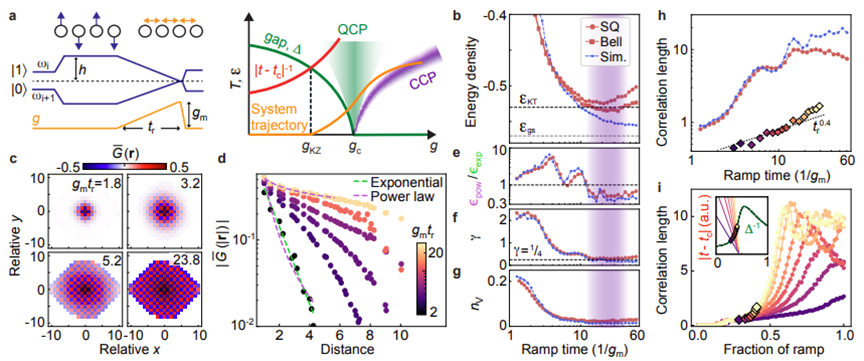Thermalization and Criticality on an Analog-Digital Quantum Simulator
1084 浏览Understanding howinteracting particles approach thermal equilibrium is a major
challenge ofquantum simulators . Unlocking the full potential of such systems toward
thisgoal requires flexible initial state preparation, precise time evolution, andextensive
probes for final state characterization. We present a quantumsimulator comprising 69
superconducting qubits which supports both universal quantumgates and high-fidelity
analog evolution, with performance beyond the reach ofclassical simulation in cross-
entropy benchmarking experiments. Emulating atwo-dimensional (2D) XY quantum
magnet, we leverage a wide range of measurementtechniques to study quantum
states after ramps from an antiferromagneticinitial state. We observe signatures of
the classical Kosterlitz-Thouless phasetransition , as well as strong deviations from
Kibble-Zurek scaling predictionsattributed to the interplay between quantum and
classical coarsening of thecorrelated domains . This interpretation is corroborated by
injecting variableenergy density into the initial state, which enables studying the
effects of theeigenstate thermalization hypothesis (ETH) in targeted parts of the
eigenspectrum. Finally, we digitally prepare the system in pairwise-entangleddimer
states and image the transport of energy and vorticity duringthermalization. These
results establish the efficacy of superconductinganalog-digital quantum processors
for preparing states across many-body spectraand unveiling their thermalization
dynamics.

Quantum and classical critical coarsening in theXY-model
Our results demonstrate a high-fidelity quantum simulator with the capability of
emulating beyond-classical chaotic dynamics, a wide range of characterization probes,
and versatile digital-analog control. Leveraging these features has enabled new i
nsights about the rich interplay of quantum and classical critical behavior in the 2D
XYmodel, including the KT transition, thermalization dynamics, and their combined
effects on the KZ scaling relations. Looking ahead, this platform is expected to offer
an invaluable playground for studies of classically intractablemany-body quantum
physics, including e.g. dynamical response functions and magnetic frustration.
Article: arXiv:2405.17385v1
